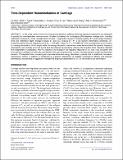Time-Dependent Nanomechanics of Cartilage
Author(s)
Han, Lin; Greene, Jacqueline J.; Lee, Hsu-Yi; Hung, Han-Hwa K.; Grodzinsky, Alan J.; Ortiz, Christine; Frank, Eliot; ... Show more Show less
DownloadHan-2011-Time-Dependent Nanom.pdf (670.6Kb)
PUBLISHER_POLICY
Publisher Policy
Article is made available in accordance with the publisher's policy and may be subject to US copyright law. Please refer to the publisher's site for terms of use.
Terms of use
Metadata
Show full item recordAbstract
In this study, atomic force microscopy-based dynamic oscillatory and force-relaxation indentation was employed to quantify the time-dependent nanomechanics of native (untreated) and proteoglycan (PG)-depleted cartilage disks, including indentation modulus E[subscript ind], force-relaxation time constant τ, magnitude of dynamic complex modulus |E*|, phase angle δ between force and indentation depth, storage modulus E′, and loss modulus E″. At ∼2 nm dynamic deformation amplitude, |E*| increased significantly with frequency from 0.22 ± 0.02 MPa (1 Hz) to 0.77 ± 0.10 MPa (316 Hz), accompanied by an increase in δ (energy dissipation). At this length scale, the energy dissipation mechanisms were deconvoluted: the dynamic frequency dependence was primarily governed by the fluid-flow-induced poroelasticity, whereas the long-time force relaxation reflected flow-independent viscoelasticity. After PG depletion, the change in the frequency response of |E*| and δ was consistent with an increase in cartilage local hydraulic permeability. Although untreated disks showed only slight dynamic amplitude-dependent behavior, PG-depleted disks showed great amplitude-enhanced energy dissipation, possibly due to additional viscoelastic mechanisms. Hence, in addition to functioning as a primary determinant of cartilage compressive stiffness and hydraulic permeability, the presence of aggrecan minimized the amplitude dependence of |E*| at nanometer-scale deformation.
Date issued
2011-04Department
Massachusetts Institute of Technology. Center for Biomedical Engineering; Massachusetts Institute of Technology. Department of Biological Engineering; Massachusetts Institute of Technology. Department of Electrical Engineering and Computer Science; Massachusetts Institute of Technology. Department of Materials Science and Engineering; Massachusetts Institute of Technology. Department of Mechanical EngineeringJournal
Biophysical Journal
Publisher
Elsevier
Citation
Han, Lin, Eliot H. Frank, Jacqueline J. Greene, Hsu-Yi Lee, Han-Hwa K. Hung, Alan J. Grodzinsky, and Christine Ortiz. “Time-Dependent Nanomechanics of Cartilage.” Biophysical Journal 100, no. 7 (April 2011): 1846–1854. © 2011 Biophysical Society
Version: Final published version
ISSN
00063495
1542-0086